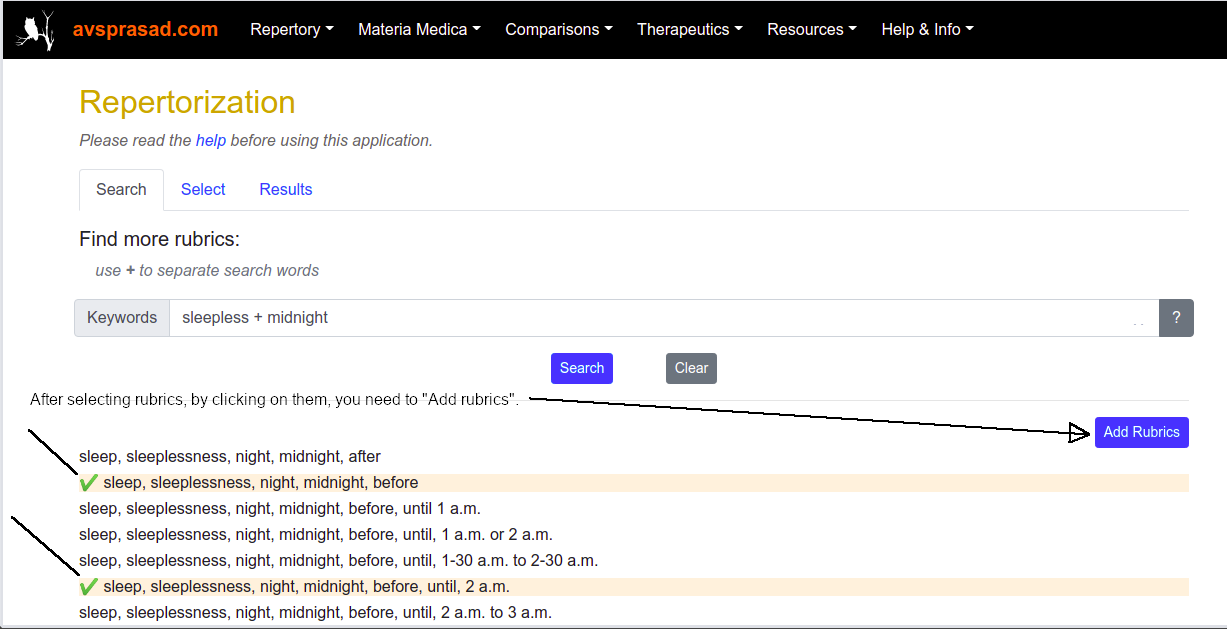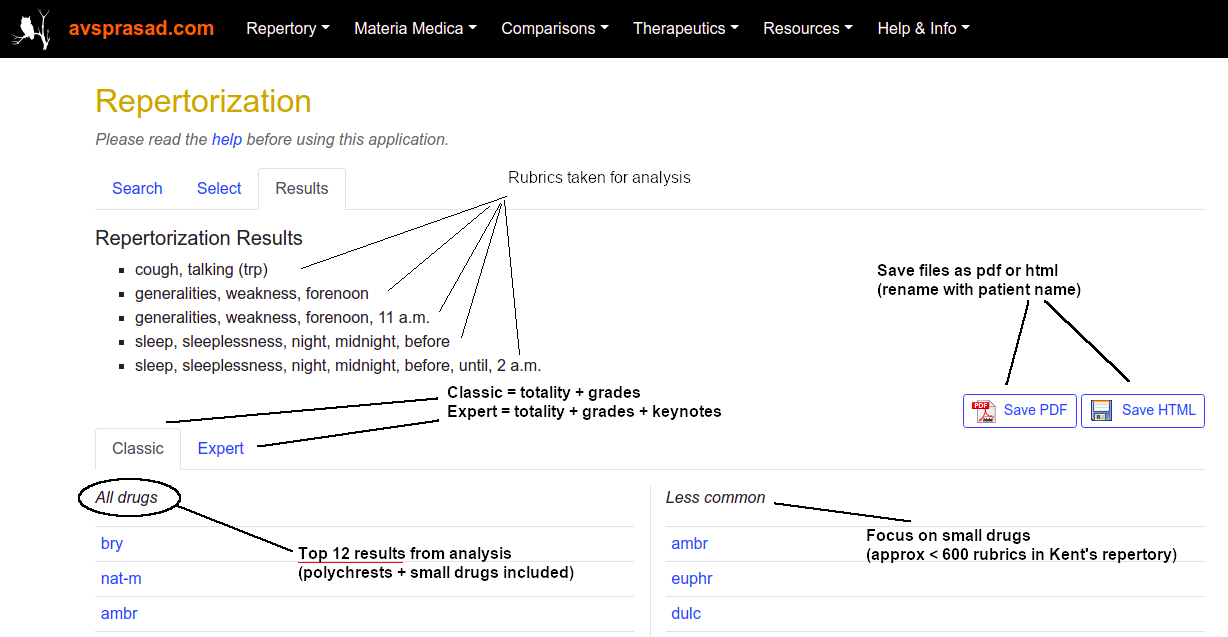How To Repertorize
Introduction
The program Repertorize is based on Kent's Repertory, with several additions from Boger Synoptic Key, Phatak's Repertory, Boericke's repertory, and also some prominent rubrics from newer repertories. It can be used on your home computer, but has also been optimized to work on any phone connected to the internet.
The program allows you to find rubrics in Kent's repertory and do a repertorial analysis. It allows regular repertorization (classic) which counts the totality and grade. In addition, using some special rules we have built into the program, it outputs an "expert" analysis which gives different results if some drugs in the analysis contain keynotes. Further, we have linked the repertorial analysis directly to materia medica, so you can confirm a drug immediately. You can view Boericke's Materia Medica or a selection of "keynote rubrics" from Kent's repertory reversed.
How to Use
The easiest way to learn and use Repertorize is by watching the Help video. Additionally, below is the sequence of steps, with screenshots.
1. Enter words in the search box and hit the Search button.

2.Select the rubrics and then "Add Rubrics". Go back to Search tab and repeat till you have your rubrics.

3. Click "Repertorize". If you want, you can de-select any rubric by clicking, and then analyze again.

4. Look at the Classic view, Expert view and Small drugs. Save the file.

Quick FAQs
These are frequently asked questions, so even before you read about how to use the App, please read these.
1. When we select rubrics for repertorization, why are the drugs not displayed for each rubric?
It is important not to be biased when selecting the rubric. There may be a desire to choose rubrics which have the drug we already feel is suitable for the case. Simply choose the rubrics that are most appropriate.
2. Why are only few drugs shown in the repertory analysis?
The top 12 drugs are shown. We felt there is little benefit in showing the 30th drug in the analysis.
3. Why are ranking counts/marks not displayed in the repertory analysis?
Because the correct prescription may fall in any of the top 12 remedies - and sometimes even outside. You should not look at 6/12 and say this is better than 4/11 (total number of rubrics/ grade total). Imagine this is a plant identification program. Just because the first one got 6/12, you don't conclude it is a Rose. You must match the picture, and then you might see that it is a cactus... pink colored, with thorns and petals etc. Always go to the materia medica and look up the top drugs.
4. How can we save the repertory analysis?
Click on either "Save PDF" or "Save HTML" in the Repertory analysis. Save the file where you want, rename to patient name.
5. Why are unrelated rubrics showing when I search for "ear + pain"?
The program searches for text within the rubric. "ear" will also find "fear" and "appear". To get an exact match, type it as "ear, pain".
6. Can classification or rubrics from pocket repertory be used in repertorization?
A. Yes. However, ensure that the similar rubrics are not repeated. If you take "thirstless" from pocket repertory and also from KentRep, the same drugs like gels, ipec may get counted twice for totality, grade etc. The same is true if you take a rubric and its subrubric with the same drug. e.g. "Teeth, pain" and "Teeth, pain, night, agg." will cause some of the same drugs to repeat.
Other important points to note:
- Search for one or more words with a + in between. Do not put any comma, dot or quotation marks etc.
- All search words need to be present in the rubric.
- Spelling errors will result in no output.
- Select and deselect the rubrics (✔) with a click.
- Add the rubrics to be repertorized.
- You can continue to select and add more rubrics and then repertorize.
- Results are shown in two columns. The left column shows all drugs from output. The right column shows only small drugs.
- The top 12 drugs of the analysis are displayed in order of ranking, highest first.
- If you click on any drug in the results, you can see the repertorization rubrics that are present in that drug, as well as go directly to the Materia Medica entry in Boericke or Kent Reversed.
- Note that all words with oe, ae etc have been simplified. So Diarrhoea = Diarrhea, Haemorrhoids = hemorrhoids. Words like aphthae remain as they are.
- Grades are as in Kent's repertory - bold is gr 3, italics is gr 2 and normal is gr 1. Keynotes are indicated by a dark brown color - independent of grade.
Special Keywords: frq, trp, pkr & classification
There are some special keywords which are present in rubrics to help focus the search. They can be used both while repertorizing as well as searching the materia medica. frq indicates rubrics that we frequently encounter in patients. trp represents rubrics that form the therapeutic indications in a specific condition. For example, you may have "head, pain, temple, left, eating after". Like this, there are thousands of specific rubrics which one may never encounter in the clinic. Much more common in headaches are - pain when going out in the sun, or from fasting etc. Such rubrics are marked with trp. A few rubrics are marked both trp and frq. Usually, frq represents more general symptoms - which can even be directly asked when thinking of / confirming a prescription.
When you search for "head, pain" or "abdomen, pain" in Kent's Repertory, you will find more than 150 drugs for each of these, which is not very useful. We have added all rubrics from our custom "Pocket Repertory" which was included in our earlier app HQR. This allows you to use the special keyword pkr (for pocket repertory) in a search. When you search "pkr head", you get headache with 23 drugs. In some situations, this may be much more useful. You could use the rubric just as a reference/lookup, or even add it to your repertorization.
Another keyword is classification, which is a classification of all the drugs. For example, simply type "classification" in the Repertory Search to see the complete list. Or search for "classification carbon".
Experiment with and without these special keywords to understand how they work. For example, try searching "stomach desire" and compare it with "stomach desire frq". In the first search, it will show you all food cravings that are present, including desire for lard, boiled milk, clean rags, etc.! The special keyword "frq" is especially useful when searching for a specific drug.